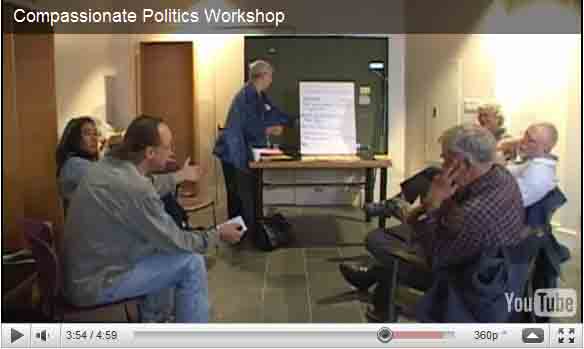|
|
Title:
1.B Meanness
Session Date and Time:
Oct 5, 2010, 2-3:30 pm
Issue/Topic:
Why are people mean to each other when they are working together and how
can we change this?

Convener/Facilitator:
Melyssa Jo Kelly
Notes-taker:
Participants:
Fred Cook, Lenel
de Emma, David Hartsough, Jan Hartsough, Stacy Kono,
Edwin Rutsch, John Testa.
Following is a report on the decisions made
in one of the Action Groups at the 9/12/10 Compassionate Politics
Workshop. Please feel free to post comments, questions, and reports on
follow through actions.
Some Causes:
-
Behavior driven by
-
ego,
-
the desire to be in control,
-
feeling “better than” others,
-
competition,
-
individualism,
-
sense of scarcity,
-
hierarchy,
-
the desire for power (also known as
“Everybody wants to be King;”)
-
people pushing their own agendas;
-
heavy-handed inter-personal dynamics;
-
the loss of tribal histories;
-
inattention to people’s feelings;
-
lack of commitment to addressing and
resolving conflicts;
-
being dualistic (seeing things as
black/white, good/bad).
Some Effects:
-
a person feels disrespected, insulted,
hurt, or unheard by someone;
-
their reaction may be defensive and
they may be mean to (or say mean things about) the person who hurt
them, beginning an endless cycle which diminishes and may destroy
a group’s ability to function.
Some Decisions:
-
Be open-hearted;
-
Use effective communication
techniques, such as;
-
Create Restorative Circles in which
people listen, take responsibility, and take action;
-
Ensure all voices are heard;
-
Be receptive to hearing other points
of view;
-
Use empathy and compassion to remove
barriers to group action;
-
Build community within a group by
trusting, being thoughtful, communicating, and repairing;
-
Act on the principle that the means is
as important as the end (the process is as important as the
production);
-
Sustain each other for the long haul;
-
Seek, listen to, and respect
everyone’s own “truth;” work with people who find common ground
and share values;
-
Try to explain your point of view and
try to understand another’s point of view;
-
Get a 360 degree perspective on group
leaders and members by seeking input from entire group;
-
First build relationships, then take
on tasks;
-
Exchange in-depth “Stories of Self”
with the whole group;
-
Discuss, dialogue, and listen;
-
Do follow-up contact;
-
Agree on a group commitment to the
process, even though individual behavior, perspectives and
priorities may differ;
-
Commit to a shared intent, process,
and project; accept people as they are, where they are;
-
Get support for yourself from people
you trust to listen to you vent, show empathy and keep
confidentiality;
-
Expect conflicts to arise;
-
Learn to see conflict as an
opportunity for learning and growth;
-
Resolve conflicts using reflective
listening to hear and be heard, and finding empathy and compassion
through deepened understanding;
-
Establish group guidelines:
-
listen,
-
no put-downs,
-
work on conflicts,
-
respect confidentiality,
-
stay accountable;
-
Make creating relationships a goal;
-
Cultivate multi-dimensionality;
-
Help everyone feel heard and have a
sense of ownership;
-
Guard against process becoming more
important than action; support, love and protect leaders;
-
Nurture leadership skills in everyone;
-
Consider needs and capacities;
-
Redefine leadership.
___Dialogue
Box ____ Comments ________ Discussions ___________
Comments 1
Comments 2
Comments 3
Comments
etc.
__________________________________________
|